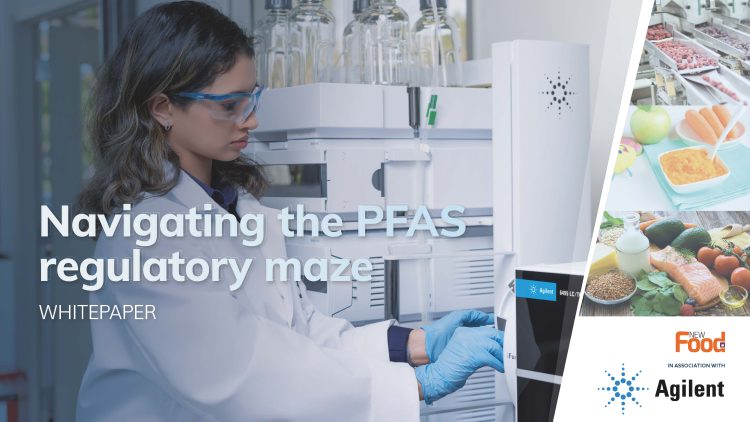Managing PFAS in the food supply chain: insights from Agilent Technologies
Posted: 30 October 2025 | Lorna De Leoz, Tarun Anumol | No comments yet
PFAS contamination continues to challenge the food and beverage sector. Agilent Technologies’ Tarun Anumol and Lorna De Leoz discuss how innovation in testing and data management is helping laboratories protect product integrity and stay ahead of regulation.


PFAS can enter the food supply at every stage, from raw ingredients to packaging, making robust testing and data management essential for food safety and regulatory compliance. Credit: Shutterstock
PFAS contamination remains one of the most complex challenges facing food and beverage producers. Found throughout production and supply chains, from water and soil to packaging and processing equipment, these substances are pushing laboratories and quality teams to rethink how they monitor and manage risk. In conversation with experts from Agilent Technologies, this discussion explores the regulatory landscape, the realities of PFAS testing and the practical steps companies can take to build more resilient, future-proofed programmes.
The current status of PFAS regulation in food
Targeted PFAS testing remains the mainstay of regulatory oversight in 2025, according to Lorna De Leoz. EU regulation 2023/915 is based on toxic equivalence and exposomic data, while US Food and Drug Administration (FDA) enforcement is case-by-case, based on toxicity and exposure. “There is still great value in targeted PFAS testing because it’s specific,” she says. “However, broader testing is increasingly important. Non-targeted analysis using high-resolution mass spectrometry or the total oxidisable precursor assays can help identify emerging PFAS.”
PFAS are everywhere and in everything. They comprise multiple chemistries, and contamination can happen at any stage – sample collection, storage, testing, even through lab equipment.”
Tarun adds context on the unique challenges: “PFAS are everywhere and in everything. They comprise multiple chemistries, and contamination can happen at any stage – sample collection, storage, testing, even through lab equipment. Labs must go back to basics to trace issues step-by-step. If you don’t, you could just find a positive, throw away a batch and pause production unnecessarily.”
For a comprehensive look at the global PFAS landscape, refer to our Navigating the PFAS regulatory maze eBook, co-created by New Food and Agilent Technologies.
Building a robust, defensible testing programme
Developing a reliable, evidence-based PFAS programme requires meticulous sampling and quality controls. Lorna advises: “Avoid cross-contamination by using PFAS-clean techniques and equipment. Document every step, from sampling procedures to materials used. Follow agency guidance on detection limits and use validated LC/MS/MS methods that address food interferences.”
You can have flawless processes, but without thorough measurement, hidden PFAS could slip through, causing brand damage or litigation.”
Tarun highlights the difficulty in practice: “Even with perfect procedures, PFAS can still show up unexpectedly. It’s critical to use blanks at different stages to trace contamination. Otherwise, you risk false positives or negatives, which could disrupt supply and damage brand trust.”
Both experts emphasise the need to not only test finished products but also raw ingredients and packaging. “PFAS can be systemically taken up by crops, end up in animal feed and cycle through the food industry,” Tarun explains. “Beer byproducts, for example, are used in bread manufacturing and animal feed, creating further exposure vectors.”
Harmonising methods across global supply chains
Global regulatory requirements remain fragmented. Lorna recommends that multinational companies harmonise their methods and reporting: “Use the same method for all testing – ingredients, materials and packaging – and align with the lowest regulatory limits globally. Uniform reporting templates make compliance simpler and more defensible.”
Tarun stresses the commercial imperative: “You need to think about your duty of care to consumers and your brand. Testing is just the start. All that data helps you decide whether to reformulate, change suppliers, or manage supply chain risk.”
Overlooked sources and audit priorities
Beyond obvious checkpoints like water and packaging, PFAS can infiltrate through less apparent routes. Lorna cites biosolids used as fertiliser, irrigation water, pesticides and processing equipment such as gaskets and tubing. “Paper-based food packaging is another source,” she notes. “You need validated methods with low detection limits and robust chain-of-custody documentation.”
Tarun adds detergents and agrochemicals to the list. “Only 28 percent of labs think their testing is sufficient. An analytical approach must be simple, scalable and continuously updated as regulations expand.”
Overcoming technical hurdles in challenging foods
High-fat products, meats, seafood and complex matrices can cause ion suppression or enhancement in mass spectrometry, affecting accuracy. Lorna explains: “Co-eluting compounds, like deoxycholic acid, can appear as PFAS signals, leading to potential false positives. Cleanup steps are essential but often skipped because of complexity.”
Tarun elaborates: “The challenge is not unique to PFAS. Sample prep before injection ensures accuracy. Our approach targets the matrix, traps interferences and allows PFAS to pass through, this simplification helps in reducing contamination points and solvent waste.”
Simplifying sample preparation
Agilent’s Captiva EMR PFAS Food I and II cartridges offer a practical solution for challenging matrices. Designed for ultra-low-level quantitation, they streamline sample preparation, remove interferences and improve reproducibility. The cartridges are automation-friendly and validated for multiple food types, from baby food and vegetables to milk, eggs, seafood and animal feed.
Adopting a proactive PFAS strategy
Market pressure often outpaces regulation. Lorna advises a comprehensive risk assessment, identifying all hidden PFAS sources and replacing materials with PFAS-free alternatives where possible. “Invest in R&D and collaborate with vendors like Agilent to innovate strategies,” she says.
Tarun concludes: “The key is measuring risk at every point. If you do that, you can manage the risk. You can have flawless processes, but without thorough measurement, hidden PFAS could slip through, causing brand damage or litigation.”
For companies looking to move from reactive crisis management to a future-proof programme, Lorna’s advice is clear: “Test everything so you can identify hidden risks.” Tarun agrees: “Think about your experimental design so you can measure every critical point. That is how you protect your brand and your supply chain.”
To learn more about PFAS in food, feed, and beverages, visit the Agilent PFAS in food testing webpages.
Meet the experts




Related topics
Contaminants, Food Safety, Regulation & Legislation, Supply chain, Water










